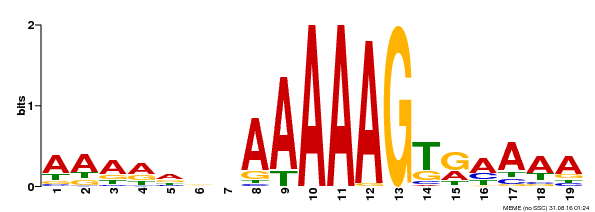| Signature Domain? help Back to Top |
 |
| No. |
Domain |
Score |
E-value |
Start |
End |
HMM Start |
HMM End |
| 1 | zf-Dof | 125.7 | 1.4e-39 | 106 | 166 | 2 | 62 |
zf-Dof 2 kekalkcprCdstntkfCyynnyslsqPryfCkaCrryWtkGGalrnvPvGggrrknkkss 62
++k+l+cprC+s++tkfCyynny+++qPr+fCkaC+ryWt+GG++rnvPvG+grrknk+ss
AT3G47500.1 106 PTKILPCPRCKSMETKFCYYNNYNINQPRHFCKACQRYWTAGGTMRNVPVGAGRRKNKSSS 166
67899*****************************************************987 PP
|
| Publications
? help Back to Top |
- Riechmann JL, et al.
Arabidopsis transcription factors: genome-wide comparative analysis among eukaryotes.
Science, 2000. 290(5499): p. 2105-10
[PMID:11118137] - Yanagisawa S
The Dof family of plant transcription factors.
Trends Plant Sci., 2002. 7(12): p. 555-60
[PMID:12475498] - Kreps JA, et al.
Transcriptome changes for Arabidopsis in response to salt, osmotic, and cold stress.
Plant Physiol., 2002. 130(4): p. 2129-41
[PMID:12481097] - Hudson ME,Lisch DR,Quail PH
The FHY3 and FAR1 genes encode transposase-related proteins involved in regulation of gene expression by the phytochrome A-signaling pathway.
Plant J., 2003. 34(4): p. 453-71
[PMID:12753585] - Lijavetzky D,Carbonero P,Vicente-Carbajosa J
Genome-wide comparative phylogenetic analysis of the rice and Arabidopsis Dof gene families.
BMC Evol. Biol., 2003. 3: p. 17
[PMID:12877745] - Yamada K, et al.
Empirical analysis of transcriptional activity in the Arabidopsis genome.
Science, 2003. 302(5646): p. 842-6
[PMID:14593172] - Tepperman JM, et al.
Expression profiling of phyB mutant demonstrates substantial contribution of other phytochromes to red-light-regulated gene expression during seedling de-etiolation.
Plant J., 2004. 38(5): p. 725-39
[PMID:15144375] - Vogel JT,Zarka DG,Van Buskirk HA,Fowler SG,Thomashow MF
Roles of the CBF2 and ZAT12 transcription factors in configuring the low temperature transcriptome of Arabidopsis.
Plant J., 2005. 41(2): p. 195-211
[PMID:15634197] - Imaizumi T,Schultz TF,Harmon FG,Ho LA,Kay SA
FKF1 F-box protein mediates cyclic degradation of a repressor of CONSTANS in Arabidopsis.
Science, 2005. 309(5732): p. 293-7
[PMID:16002617] - Delessert C, et al.
The transcription factor ATAF2 represses the expression of pathogenesis-related genes in Arabidopsis.
Plant J., 2005. 43(5): p. 745-57
[PMID:16115070] - Duarte JM, et al.
Expression pattern shifts following duplication indicative of subfunctionalization and neofunctionalization in regulatory genes of Arabidopsis.
Mol. Biol. Evol., 2006. 23(2): p. 469-78
[PMID:16280546] - Khanna R, et al.
Functional profiling reveals that only a small number of phytochrome-regulated early-response genes in Arabidopsis are necessary for optimal deetiolation.
Plant Cell, 2006. 18(9): p. 2157-71
[PMID:16891401] - Chawade A,Br
Putative cold acclimation pathways in Arabidopsis thaliana identified by a combined analysis of mRNA co-expression patterns, promoter motifs and transcription factors.
BMC Genomics, 2007. 8: p. 304
[PMID:17764576] - Ascencio-Ib
Global analysis of Arabidopsis gene expression uncovers a complex array of changes impacting pathogen response and cell cycle during geminivirus infection.
Plant Physiol., 2008. 148(1): p. 436-54
[PMID:18650403] - Borges F, et al.
Comparative transcriptomics of Arabidopsis sperm cells.
Plant Physiol., 2008. 148(2): p. 1168-81
[PMID:18667720] - Wang Y, et al.
Transcriptome analyses show changes in gene expression to accompany pollen germination and tube growth in Arabidopsis.
Plant Physiol., 2008. 148(3): p. 1201-11
[PMID:18775970] - Fornara F, et al.
Arabidopsis DOF transcription factors act redundantly to reduce CONSTANS expression and are essential for a photoperiodic flowering response.
Dev. Cell, 2009. 17(1): p. 75-86
[PMID:19619493] - Jung CH,Wong CE,Singh MB,Bhalla PL
Comparative genomic analysis of soybean flowering genes.
PLoS ONE, 2012. 7(6): p. e38250
[PMID:22679494] - Ding Y, et al.
Four distinct types of dehydration stress memory genes in Arabidopsis thaliana.
BMC Plant Biol., 2013. 13: p. 229
[PMID:24377444] - Corrales AR, et al.
Multifaceted role of cycling DOF factor 3 (CDF3) in the regulation of flowering time and abiotic stress responses in Arabidopsis.
Plant Cell Environ., 2017. 40(5): p. 748-764
[PMID:28044345] - Renau-Morata B, et al.
Ectopic Expression of CDF3 Genes in Tomato Enhances Biomass Production and Yield under Salinity Stress Conditions.
Front Plant Sci, 2017. 8: p. 660
[PMID:28515731] - Henriques R, et al.
The antiphasic regulatory module comprising CDF5 and its antisense RNA FLORE links the circadian clock to photoperiodic flowering.
New Phytol., 2017. 216(3): p. 854-867
[PMID:28758689]
|





